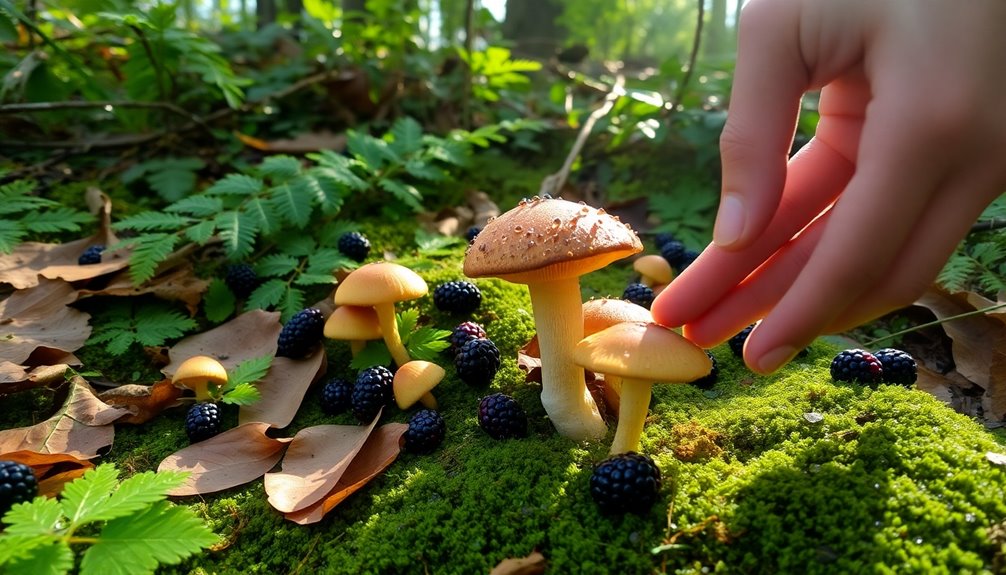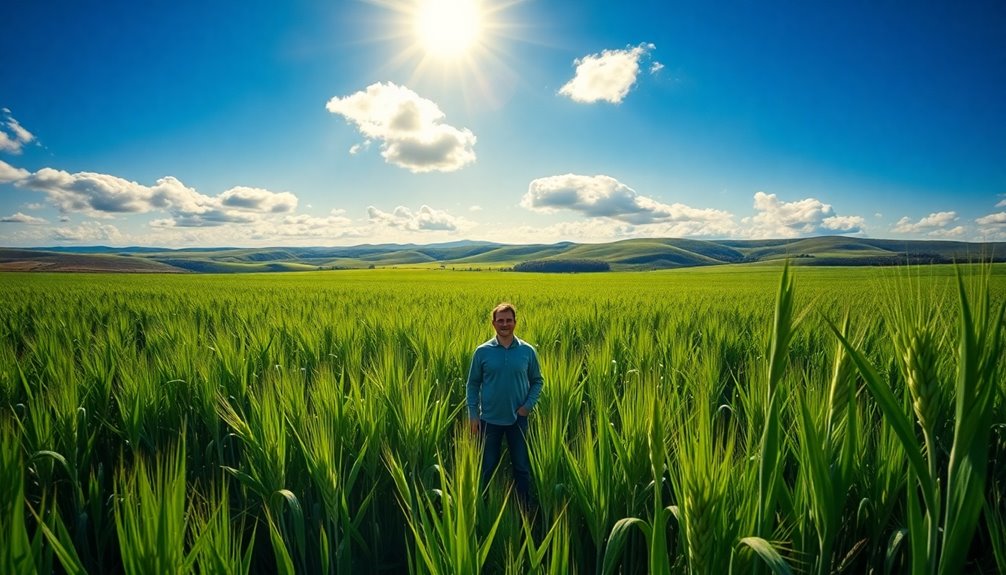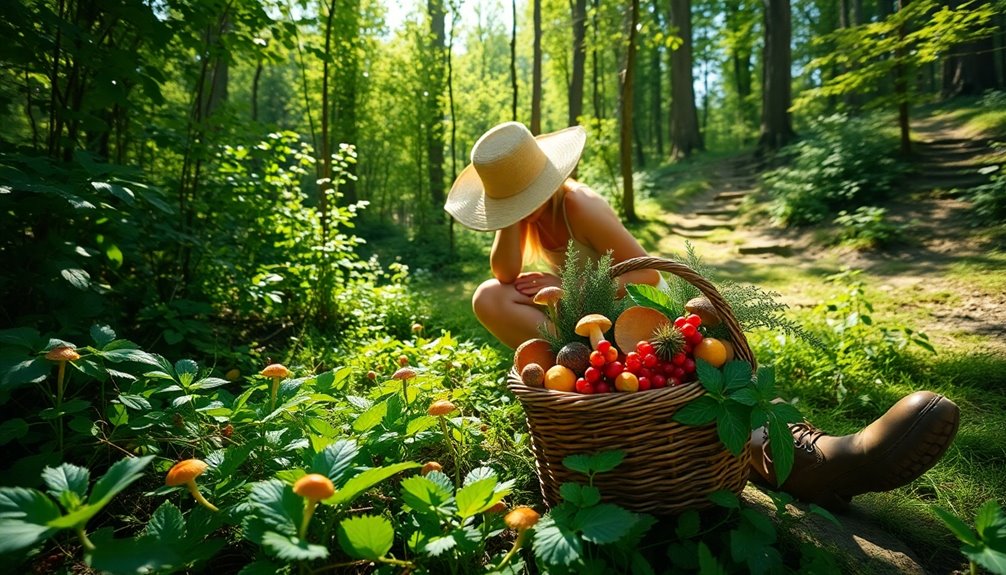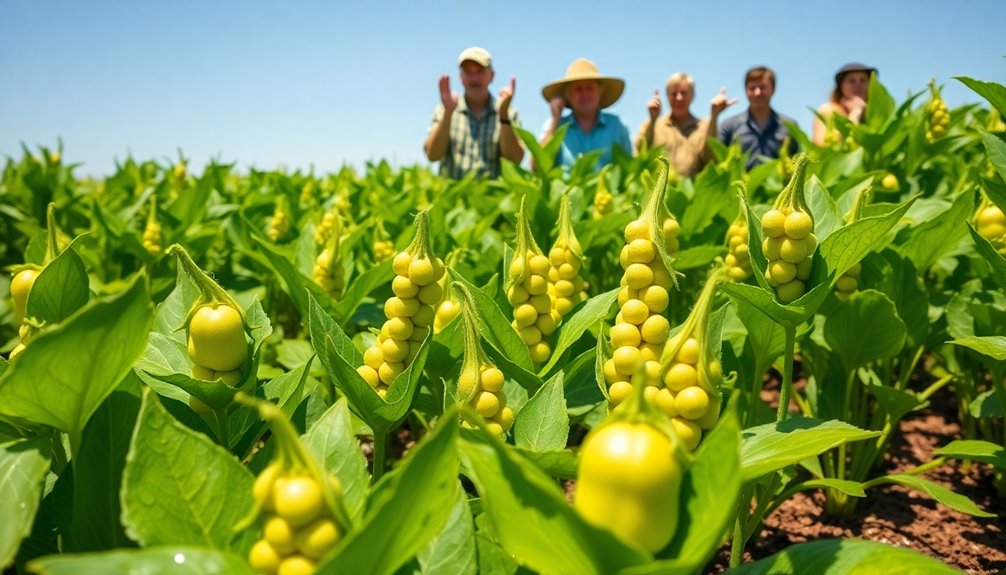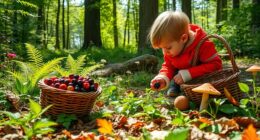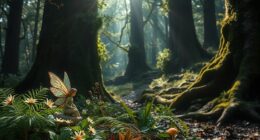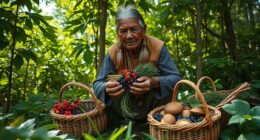Right now, November brings a fantastic selection of foraged goodies waiting for you. Look for chickweed, wintercress, hickory nuts, and black walnuts. If you're a mushroom lover, Chicken of the Woods and Oyster mushrooms are in season. Don't forget to hunt for sweet persimmons, best picked after the first frost. By foraging these seasonal treats, you'll not only enhance your meals but also connect with nature. Plus, you'll support local ecosystems. So, grab a basket and explore your area's hidden bounty—there's plenty more to uncover out there.
Key Takeaways
- In November, you can find chickweed, wintercress, hickory nuts, and black walnuts for foraging.
- Edible mushrooms like Chicken of the Woods and Oyster mushrooms are also available during this season.
- Sweet persimmons are best harvested after the first frost, enhancing their flavor.
- Foraging in this season promotes a diverse diet with nutrient-rich wild edibles.
- Remember to forage sustainably, adhering to the "one-third rule" to protect plant populations.
Understanding Wild Edibles
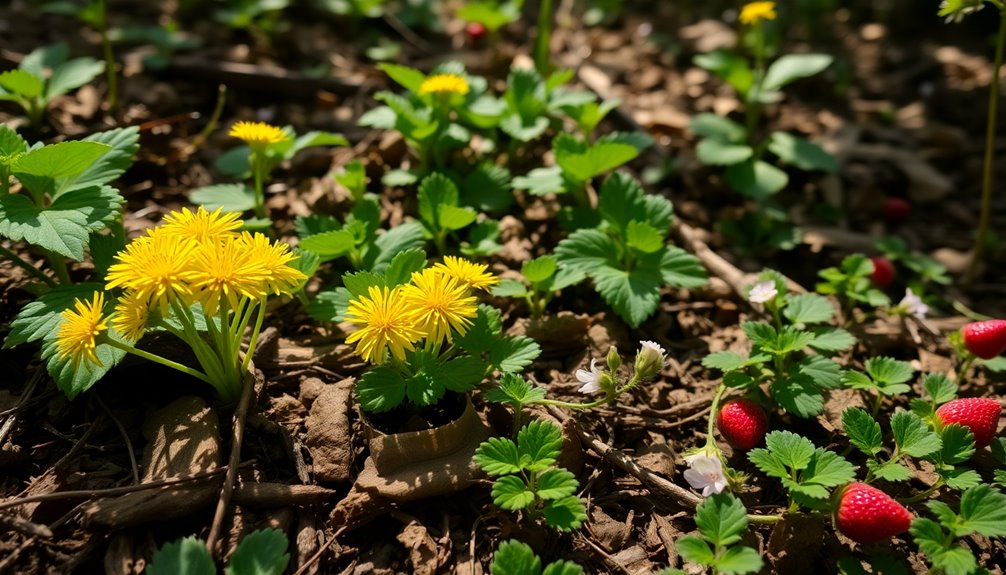
When it comes to foraging, understanding wild edibles is key to safely enjoying nature's bounty. These naturally occurring plants not only enrich your diet but often pack more nutrients than their cultivated counterparts. Additionally, many cultures have historically relied on foraging baskets to gather these wild edibles efficiently. Bees' foraging range also plays a crucial role in the availability of some of these plants, as their pollination helps sustain wild edibles.
However, proper identification of edible plants is essential; some may be toxic. As you set off on your foraging journey, consider using field guides or joining local foraging groups to help you learn. Local foraging groups often provide invaluable resources and workshops on foraging to enhance your knowledge.
Spring offers prime opportunities to find a variety of wild edibles like nettles, ramps, dandelions, and violets. Mushroom foraging can also be a rewarding experience during this season, as various species begin to emerge.
Remember to practice ethical foraging by adhering to the one-third rule—only harvest a third of what you find to maintain ecological balance. This practice guarantees that the plants can continue to thrive for future foragers.
Once you've gathered your wild edibles, you can enhance their flavors and nutritional benefits through various cooking techniques. Sautéing, blanching, or adding them to soups and salads can elevate your meals.
By understanding wild edibles and how to identify them, you'll not only enjoy delicious dishes but also connect more deeply with the natural world around you. Happy foraging!
Seasonal Wild Edibles Overview
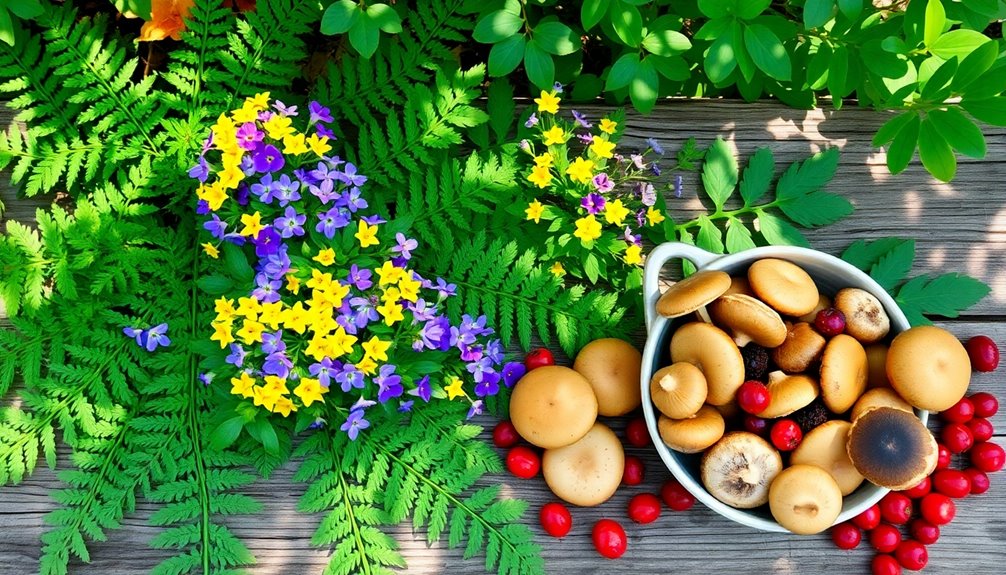
As the seasons change, so do the wild edibles waiting for you to discover them.
Right now, you can find a variety of greens and herbs ready for your kitchen, along with tips to enhance your foraging skills.
Let's explore what's currently available and how to make the most of your foraging adventures.
Current Edibles Available
If you're out foraging in November, you'll be delighted to discover a variety of seasonal edibles that can enhance your meals. Among the wild edible plants you can find are chickweed and wintercress, which thrive in the colder months. Packed with vitamins A and C, these greens can brighten up salads or stir-fries.
As the leaves fall, nuts like hickory and black walnuts become available. They're a fantastic source of energy and nutrition, plus you won't have to worry about poisonous look-alikes, making them safe for foraging enthusiasts.
Don't overlook the edible mushrooms, either. Chicken of the Woods and Oyster mushrooms are still ripe for the picking, known for their unique flavors and versatility.
You may also come across sweet persimmons, best harvested after the first frost. These fruits are perfect for desserts or can be preserved for later enjoyment.
Embracing seasonal foraging not only enriches your culinary experiences but also supports sustainability, reconnecting you with nature and its hidden treasures.
Seasonal Foraging Tips
Exploring the world of seasonal foraging opens up a wealth of opportunities throughout the year.
Spring is an ideal time, as wild edible plants like nettles, ramps, and violets thrive in moist, disturbed areas. In April, keep an eye out for fresh herbs and greens such as wild chives and sorrel, which can elevate your dishes with vibrant flavors. The diverse plant life during this season can also be linked to increased feelings of happiness due to the connection with nature. Additionally, foraging can provide access to various nutritional benefits found in seasonal wild edibles, such as those derived from antioxidants and vitamins present in plants like yerba mate. During this time, consider how diversifying your diet with foraged foods can enhance your overall health.
As May arrives, it marks the peak season for wild herbs and edible plants. This is when you should arm yourself with identification guides to guarantee you're foraging safely. Remember, knowing what you're picking is vital not only for your health but also for sustainability. Respecting local ecosystems helps maintain biodiversity, which is key to successful foraging. Additionally, incorporating proper nutrition from foraged foods can enhance your overall cognitive and emotional well-being.
When June rolls around, you'll find edible flowers and tender leaves like elderflower. These are perfect for summer recipes that can enhance your culinary creativity. Utilizing these seasonal ingredients can also promote relaxation and reduce anxiety symptoms, making your meals not just delicious but also beneficial for your well-being.
By following these seasonal foraging tips, you'll not only enjoy the benefits of fresh, wild foods but also develop a deeper connection with the natural world around you.
Key Spring Edibles to Forage
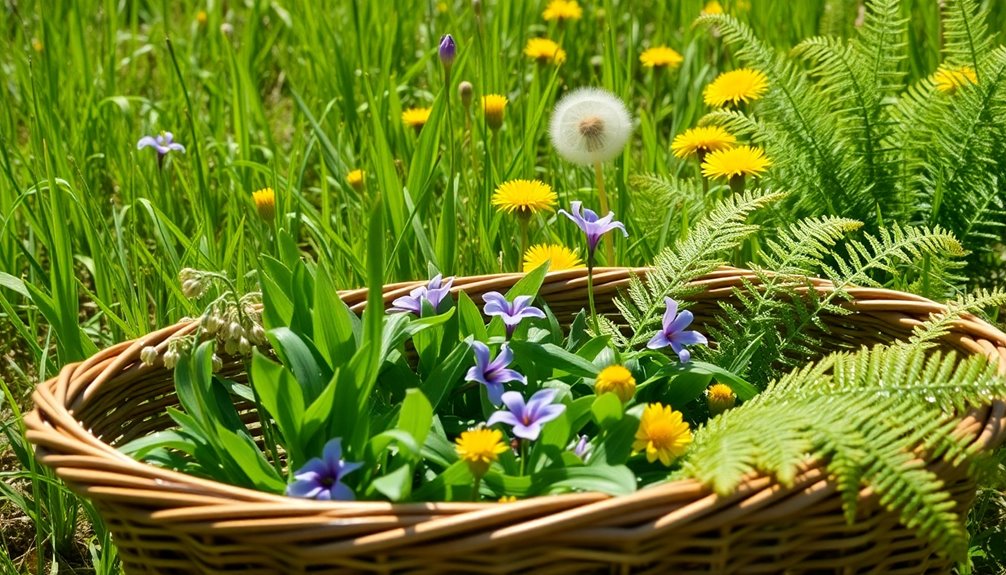
As you explore the spring landscape, you'll discover a variety of nutritious edibles waiting to be foraged.
From the rich vitamins in nettles to the flavorful wild ramps, these foods not only boost your health but also connect you to sustainable practices.
Nutritional Benefits of Foraged Foods
Spring brings a bounty of wild edibles that not only enhance your meals but also pack a powerful nutritional punch. Foraging for these greens gives you access to a variety of nutrient-dense foods that can greatly boost your diet.
Take nettles, for example. Packed with Vitamins A, C, K, iron, and calcium, they outshine many cultivated greens regarding nutritional benefits.
Cattails thrive in wet areas and offer multiple edible parts, from shoots to roots, providing a good source of carbohydrates and essential nutrients.
Violets, with their vibrant colors, aren't just pretty; they also bring antioxidants to your salads or as garnishes, elevating both nutrition and aesthetics.
Don't overlook ramps, either. These seasonal delicacies bring a robust onion-garlic flavor and are high in Vitamins A and C.
Finally, fiddleheads from ostrich ferns are rich in antioxidants and omega-3 fatty acids, making them a nutrient-dense addition to your spring dishes. Additionally, incorporating chia seeds into your foraged meals can further enhance their nutritional value due to their high omega-3 fatty acids content.
Sustainable Foraging Practices
Sustainable foraging practices are vital for guaranteeing that wild edible plants continue to thrive in our ecosystems. By adopting a sustainable lifestyle, you can help maintain ecological balance. An important guideline is the "one-third rule," which suggests harvesting no more than a third of available resources. This way, you allow plant populations to regenerate.
In spring, key edibles like nettles and ramps are plentiful. Nettles are packed with vitamins A and C, but remember to cook them to neutralize their stinging hairs. When foraging for ramps, only take a few leaves from each plant to promote their sustainability.
Cattails are another great option, offering young shoots and pollen, but be careful not to over-harvest, as this can harm local wetland habitats.
Ethical foraging also involves properly identifying plants to avoid toxic species. Utilize field guides and local foraging clubs to enhance your knowledge and safety. By engaging with local ecosystems, you foster appreciation for biodiversity and promote responsible stewardship. Additionally, being aware of best safety tools can enhance your foraging experience by ensuring you are prepared for any unexpected situations.
Caring for the environment while enjoying nature's bounty makes your foraging experience not only rewarding but also sustainable.
Delicious Recipes With Wild Ingredients
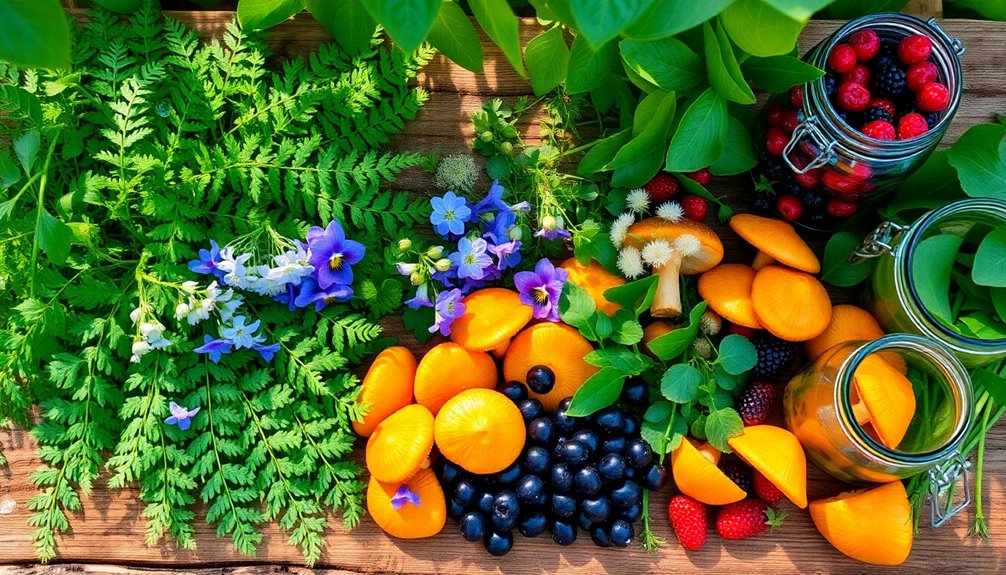
Discover the joy of cooking with wild ingredients that not only elevate your dishes but also connect you to nature's bounty. Incorporating wild food into your meals is a fantastic way to enjoy edible plants while harnessing their unique flavors and health benefits.
Start with a nutritious Nepali Nettle Soup by boiling fresh wild nettles with rice and sautéing garlic in butter. This combination creates a hearty dish packed with nutrients and may also provide anti-inflammatory properties that contribute to overall wellness.
For a sweeter touch, make Violet Jelly by steeping violet petals in boiling water, straining the juice, and mixing it with sugar and pectin.
If you're looking to enhance your savory dishes, experiment with wild ramps. These flavorful greens can be blended into a vibrant pesto or sautéed to enrich meats and vegetables.
Don't forget fiddleheads—these coiled young ferns can be blanched and sautéed in garlic and olive oil for a rich, antioxidant-packed side.
Lastly, use wild fruits like elderberries to craft homemade syrups or jams. This not only preserves the seasonal flavors but also offers a delicious way to enjoy the health benefits of these wild ingredients. Additionally, incorporating natural antioxidants into your diet can further enhance your health while enjoying these seasonal delights.
Happy cooking!
Foraging Techniques and Best Practices
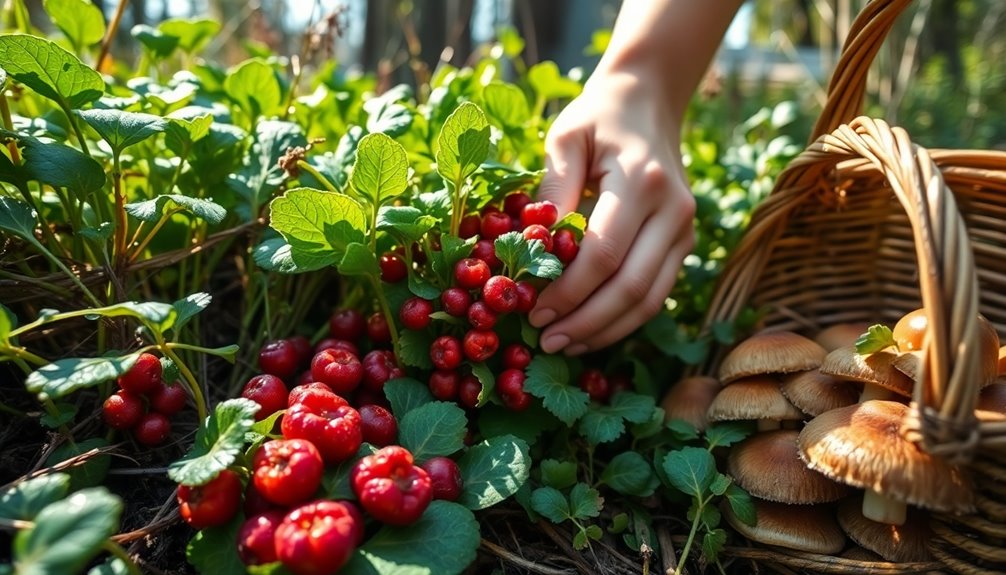
Foraging connects you directly to nature, but it requires knowledge and care. Mastering foraging techniques is essential for safely enjoying wild edible plants. Start by verifying proper identification; always use field guides or smartphone apps to confirm that what you've found is safe to eat. When in doubt, don't consume it.
Remember the "one-third rule" when harvesting. Collect only one-third of any wild edible population to maintain ecological balance and guarantee future foraging success.
If you're foraging for mushrooms, carry a reliable guide. Many edible varieties have toxic look-alikes that can lead to serious health risks.
Timing is also key. Plan your foraging outings according to the seasonality of wild edibles. For instance, nettles are abundant in spring, while blackberries peak in summer.
Lastly, respect private property and local regulations. Always seek permission before foraging on private lands, and be aware of any protected species in your area.
Benefits of Foraged Foods
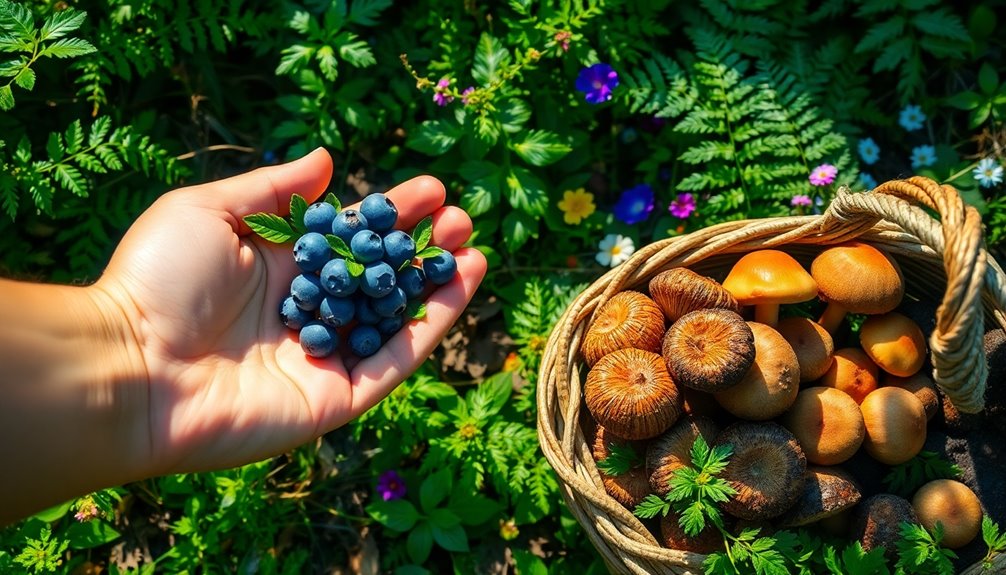
Foraged foods pack a nutritional punch, often offering more vitamins and minerals than their cultivated counterparts.
By choosing wild edibles, you not only support your health but also contribute to environmental sustainability and reduce your carbon footprint.
Plus, foraging provides a wallet-friendly way to enjoy fresh ingredients right from your local landscape.
Nutritional Value and Diversity
Throughout the seasons, incorporating foraged foods into your diet can greatly boost your nutritional intake. Wild edible plants, like nettles and wild garlic, pack a punch with vitamins A, C, and K. These essential nutrients support your immune function and enhance overall health.
When you forage for seasonal produce, such as berries and nuts, you not only diversify your meals but also introduce exciting flavors and textures to your culinary repertoire.
Foraged foods often have higher nutritional value compared to cultivated options. Wild mushrooms and greens, for instance, usually contain elevated levels of vitamins, minerals, and antioxidants, enriching your diet.
Unique foraged items like fiddleheads and ramps bring phytochemicals that may offer anti-inflammatory and antioxidant benefits, leading to better health outcomes.
Plus, foraging can be a cost-effective way to eat well. As these foods are typically free, you can reduce your reliance on store-bought produce while supporting a sustainable local food system.
Environmental Sustainability Benefits
Exploring the world of wild edibles offers significant environmental sustainability benefits that can positively impact both your health and the planet. Foraged foods are often richer in vitamins and minerals than conventionally cultivated produce, providing a nutrient-dense alternative that supports overall health. By sourcing your food through foraging, you actively reduce the carbon footprint associated with agricultural production and transportation, promoting a more sustainable food system.
Engaging in foraging also fosters a deeper appreciation for local ecosystems and biodiversity. As you learn about the plants and habitats around you, you're encouraged to preserve and protect these natural spaces. Foraged foods come at no cost, allowing you to access high-quality ingredients while supporting economic sustainability in local communities.
Practicing sustainable foraging techniques, like the one-third rule, helps maintain ecological balance. This method guarantees that wild food populations can regenerate and thrive for future generations.
Cost-Effective Food Source
When you venture into foraging, you reveal a treasure trove of cost-effective food options that can greatly reduce your grocery bills. Instead of spending on organic produce, you can access nutritious edible plants like wild greens, mushrooms, and berries for free.
These wild edibles, such as dandelions and nettles, are packed with vitamins and minerals, often providing more nutrition than their cultivated counterparts.
By foraging, you can greatly cut your grocery expenses, especially since common wild foods like ramps, wild garlic, and fiddleheads are abundant during their peak seasons. This self-sufficiency not only eases your budget but also allows you to gather your own food, which is particularly beneficial when traditional produce prices rise.
Engaging in foraging fosters a deeper connection with your local ecosystem while encouraging sustainable practices. Not only do you save money, but you also support your health and the environment. Moreover, foraging can be an excellent way to enhance your well-being through the consumption of fresh, wild foods that contribute to a healthier lifestyle.
Popular Foraged Plants and Mushrooms
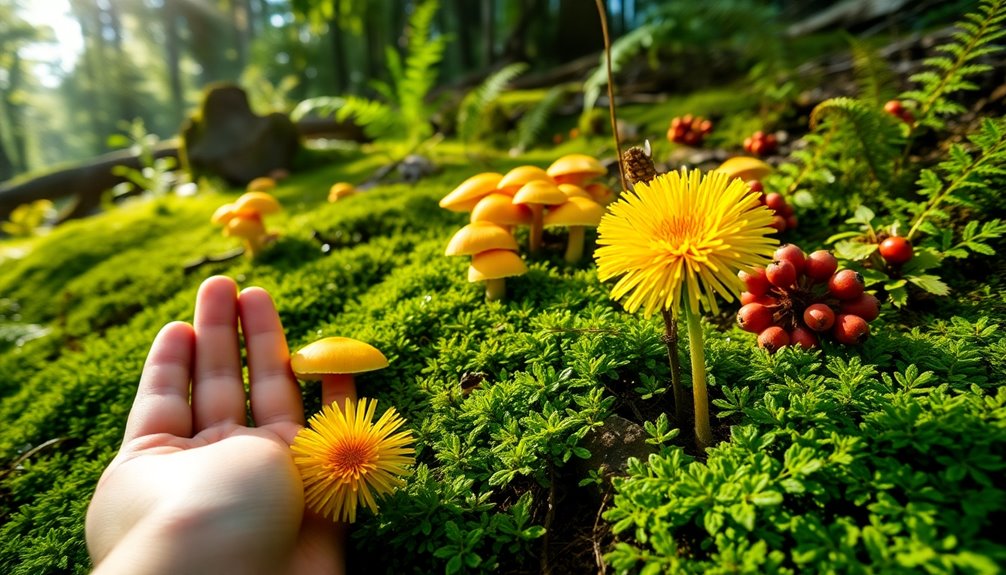
Foraging offers a delightful adventure into nature, revealing a variety of popular plants and mushrooms that are both nutritious and flavorful.
In spring, you'll find many edible wild treats that can elevate your meals and boost your health. Here are some must-try foraged options:
- Nettles: Nutritious and rich in vitamins A, C, K, iron, and calcium; always cook or dry them to neutralize their stinging hairs. Additionally, incorporating essential oils for toothache relief can enhance your wellness routine. Nettles have also been recognized for their potential to reduce inflammation in the body, making them a great addition to your diet. They are also high in fiber content, which can promote satiety. Moreover, they can also provide health benefits such as improved urinary health.
- Cattails: Found in wet areas, their young shoots, pollen, and roots are all edible, making them a versatile addition to your foraging repertoire. Their high fiber content can also help with digestion.
- Wild Violets: These colorful flowers come in purple, yellow, and white. They're not only edible but can also spruce up salads and desserts when candied. Additionally, their antioxidant properties can contribute to overall health.
- Ramps: With a distinct onion-garlic scent, these wild leeks thrive in moist, wooded areas; you can enjoy them fresh or preserved. Their unique flavor enhances many dishes, making them a sought-after ingredient.
As you explore the great outdoors this spring, keep an eye out for these popular foraged plants. Remember that foraging can also be a wonderful way to connect with nature and enhance your vibrational energy, making your foraging experience all the more rewarding.
Each one brings unique flavors and health benefits, making your foraging experience all the more rewarding.
Engaging With the Foraging Community
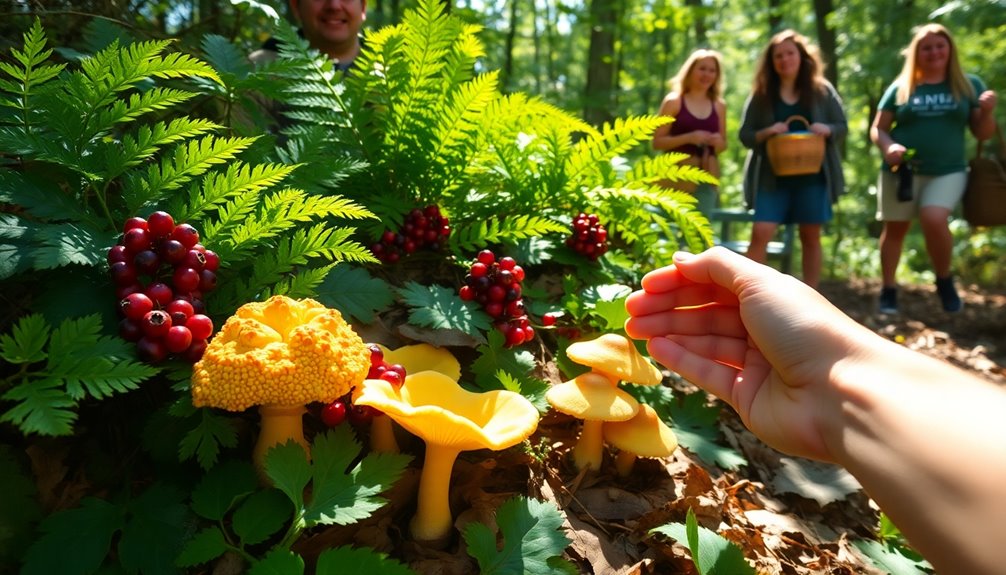
Connecting with others who share your passion for foraging can enhance your experience and knowledge. Joining local foraging clubs or online communities opens doors to valuable resources, tips, and shared experiences.
You'll gain insights into proper identification techniques and sustainable harvesting practices by participating in workshops and guided foraging tours led by experienced foragers.
Engaging with the community can be incredibly rewarding. You can share your personal foraging adventures on social media, inspiring others to explore wild edibles while fostering a sense of belonging among fellow enthusiasts.
Join forums or groups dedicated to wild food foraging to exchange recipes and discuss the seasonal availability of your favorite foraged ingredients.
Don't miss out on community foraging events, like group forays or potlucks featuring foraged dishes. These gatherings not only strengthen connections between members but also promote responsible foraging within local ecosystems.
As you connect with others, you'll deepen your understanding of foraging and develop lasting friendships. Embrace the opportunity to learn and grow alongside fellow foragers, and let the community elevate your foraging journey.
Ethical Foraging Practices
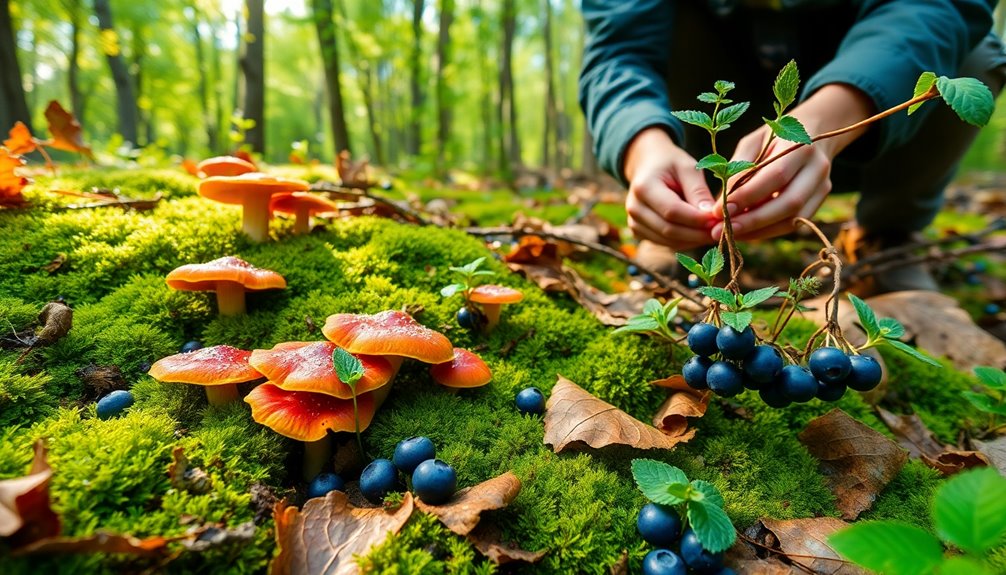
Engaging in ethical foraging practices is essential for preserving our natural ecosystems and ensuring the sustainability of wild food sources.
By adopting responsible habits, you can enjoy wild edible plants while protecting the environment. Here are some key guidelines to follow:
- Follow the one-third rule: Only harvest a third of a plant population to maintain ecological balance.
- Ask for permission: Always seek permission before foraging on private lands, respecting property rights and building good relationships with landowners.
- Identify accurately: Use field guides or apps to accurately identify plants and mushrooms, avoiding toxic species that can pose serious health risks.
- Leave no trace: Minimize your environmental impact by ensuring habitats remain undisturbed for wildlife and future foragers.
Future Foraging Adventures
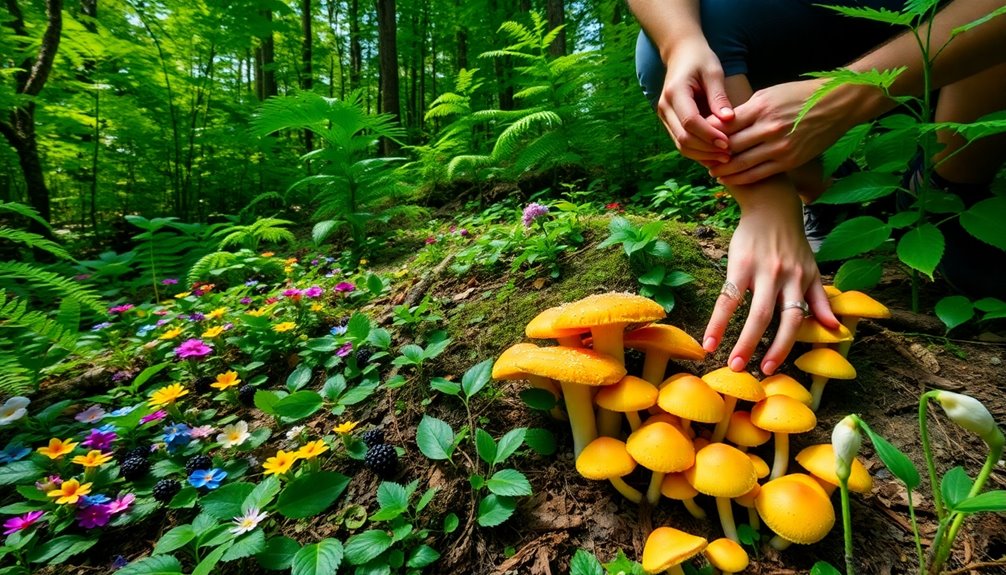
There's a whole world of wild edibles waiting to be discovered, and future foraging adventures can be a thrilling way to connect with nature. By exploring diverse ecosystems like wetlands and forests, you can maximize the variety of wild plants you harvest throughout the seasons.
For instance, look for cattails in marshy areas or ramps in shady woodlands.
Engaging in local foraging workshops or community events can boost your knowledge of sustainable practices and improve your identification skills. You'll meet fellow foragers who share your passion, enriching your experience.
Additionally, a seasonal foraging calendar can help you plan your outings; knowing when wild garlic peaks in March or blackberries ripen in August will keep your foraging adventures exciting and fruitful.
Utilizing mobile apps and online resources for plant identification guarantees safer foraging experiences, allowing you to confidently distinguish between edible and toxic species.
Finally, consider documenting your foraging journeys through journaling or photography. This not only deepens your understanding of local flora but also fosters ongoing learning and sharing within the foraging community.
Enjoy your future foraging adventures!
Frequently Asked Questions
What Is the Golden Rule of Foraging?
The golden rule of foraging is simple: only harvest what you can positively identify as edible.
If you're unsure about a plant or mushroom, it's best to leave it alone. Consuming unknown species can lead to serious health risks.
To stay safe, educate yourself about wild edibles and their habitats. Knowing what's safe to eat guarantees your foraging experience is enjoyable and responsible, keeping both you and the ecosystem healthy.
What Not to Eat When Foraging?
When you're wandering through nature's pantry, remember: not everything that glitters is gold.
Avoid plants with milky or latex sap; they often signal toxicity.
Steer clear of mushrooms unless you can identify them with certainty—many look-alikes can be deadly.
Bright red or orange berries are usually a no-go, and be cautious of the carrot family.
If you can't identify a plant or mushroom, leave it alone.
Safety first!
In What States Is Foraging Illegal?
Foraging isn't allowed in several states, particularly on public lands.
In California, strict regulations prohibit collecting most wild plants without permits.
Hawaii has heavy restrictions on native plants, and Massachusetts requires adherence to local conservation laws.
Even in New York, you might face limits on how much you can gather, especially with endangered species.
Always check local laws to know what's legal in your area before you head out foraging.
What Is the Forage Season?
Foraging fascinates folks throughout the year, with forage seasons fluctuating by region.
In spring, you'll spot sprightly wild greens like nettles and ramps.
Summer brings sweet sensations, with strawberries and blackberries ripe for picking.
As fall arrives, you can scout for savory nuts and mushrooms.
Even in winter, resilient plants like chickweed persist.
Embrace the bounty of each season and discover nature's diverse delights waiting just outside your door!
Conclusion
As you step into nature's pantry, remember that foraging is more than just gathering food—it's an adventure waiting to unfold. By embracing seasonal wild edibles, you're not just tasting the earth's bounty, but also connecting with the vibrant tapestry of life around you. So grab your basket and explore! Each foraged treasure you find can ignite your culinary creativity and deepen your bond with nature. Immerse yourself, and let the wild flavors inspire your next meal!

